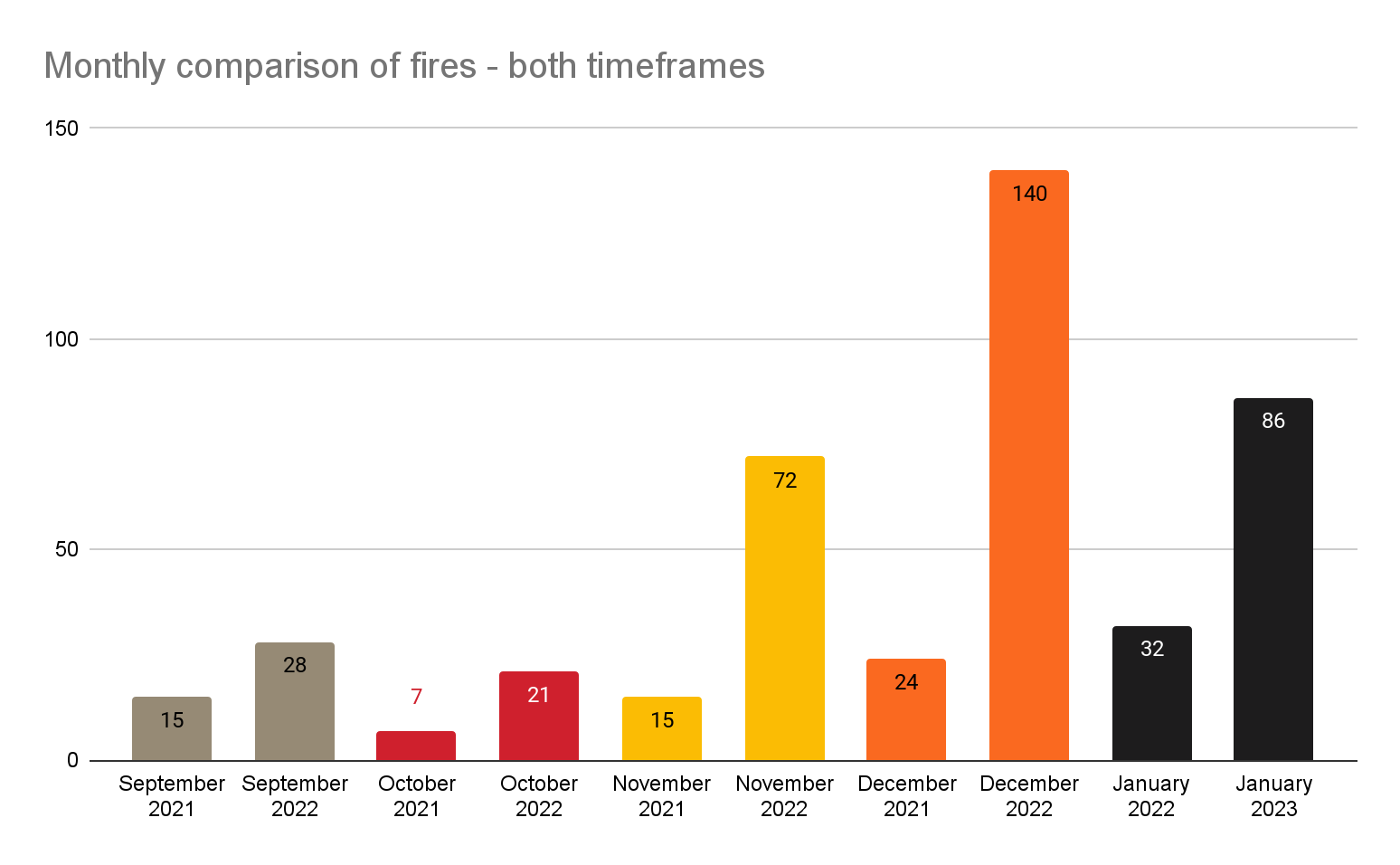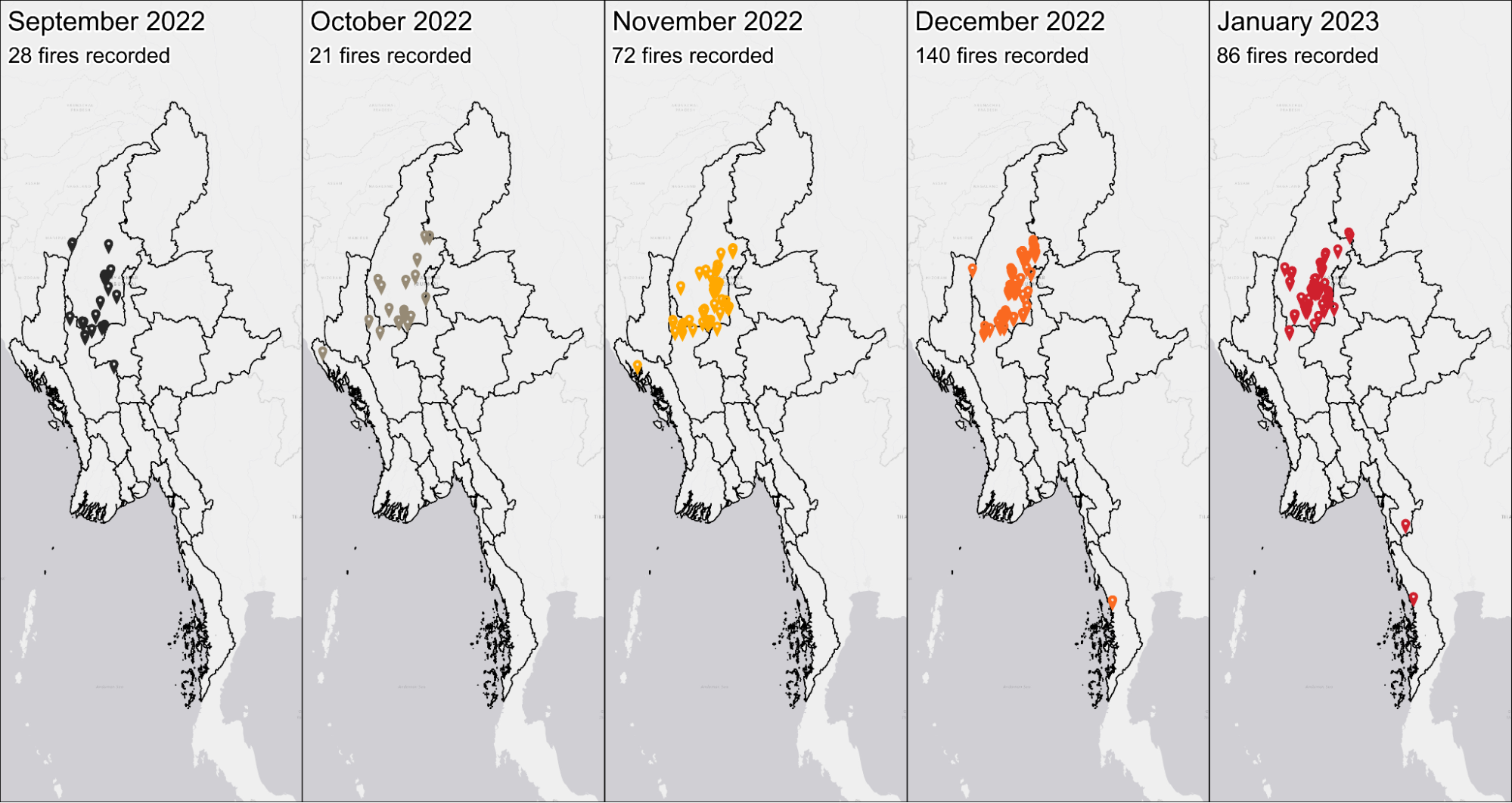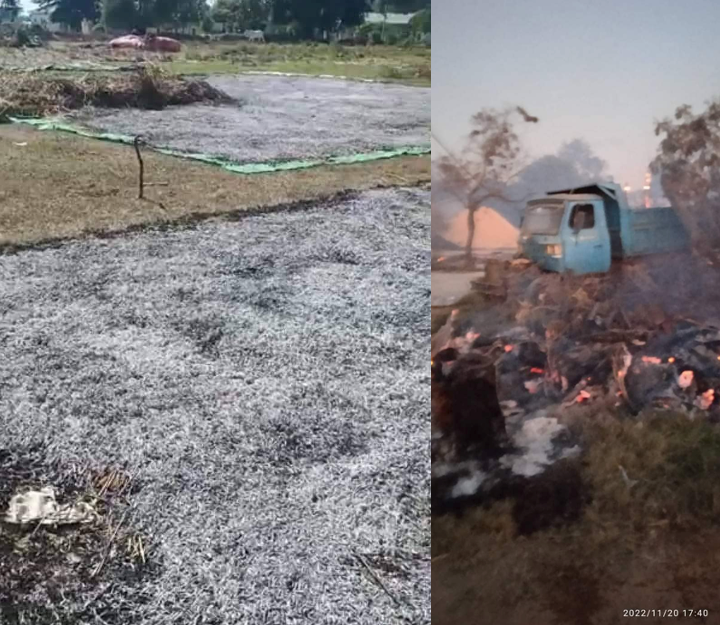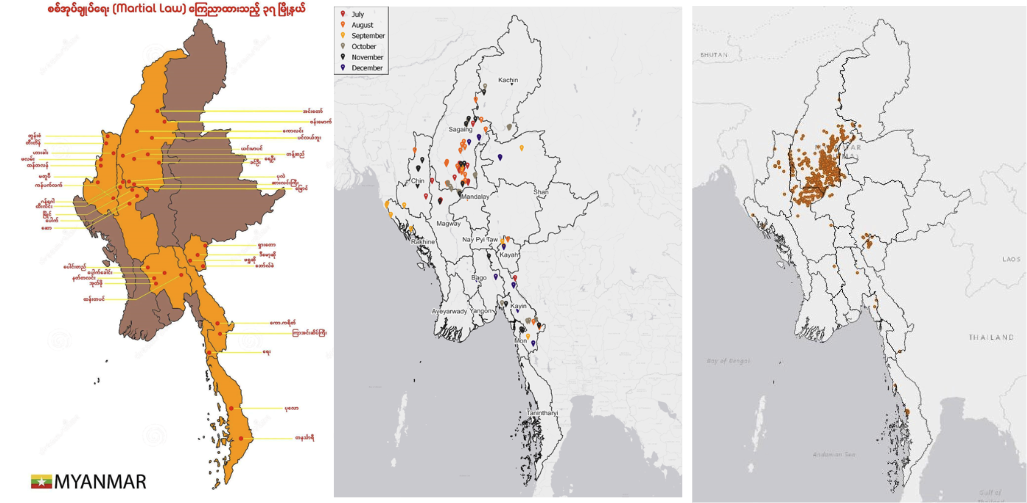Executive Summary
To read the full report, download the PDF.
Since the February 2021 coup, the Myanmar military has violently suppressed political opposition and used disproportionate violence against civilians. As the Myanmar military struggles to exert control over areas of resistance, persistent fires have been on the rise – likely as part of both the Myanmar military’s offensive against PDF groups, and their attempts to subjugate the civilian populations.
This report by Myanmar Witness seeks to provide insight into this modus operandi of the Myanmar military by assessing data and specific case studies. This paper reviews what are alleged to be intentionally set fires in Myanmar, which has been a consistent feature of the conflict.

Figure: Map showing all fire data collected and analysed by Myanmar Witness as of 31 January 2023.
The use of fire has increased, resulting in the destruction of thousands of homes. As part of enduring monitoring of fire, Myanmar Witness observed a sharp increase in the number of fires being reported around Myanmar at the end of 2022 – with the largest change being an astounding 454% year-on-year increase in December. In every month observed between September 2022 and January 2023, Myanmar Witness collected more fire incidents than in the corresponding months in the previous year.

Figure: Fire incidents by month, June 2021 to January 2023.

Figure: Comparison of fire incidents between September and January in both 2021 and 2022.
Myanmar Witness has sought to understand this increase through investigation and analysis of fires in the months of September 2022 to December 2022. To understand this phenomena, Myanmar Witness has analysed large patterns of fires, turning these into case studies that demonstrate the potential systematic nature in which villages are being affected by fire. Myanmar Witness has found that these fires appear to happen in ‘clusters’, with repeated incidents in the same villages over time, as well as multiple simultaneous incidents in multiple villages in the same area. This is a pattern also observed in the wider fire dataset and in operations between September 2021 and January 2022, which can be read about in more detail in Myanmar Witness’ report, Civilian Harm.

Figure: Increases in fire incidents by state between September – January, 2021 and 2022.
Myanmar Witness has collected 347 reports of fires during the period of September 2022 to January 2023. The team have then selected five case studies that are representative of trends observed across the wider set. In some of the selected case studies, fires seem to correlate with People Defence Force (PDF) activity and it is therefore a realistic possibility that they can be explained as retaliation for said activity by Myanmar’s Military. The case studies also demonstrate the way in which fire is used as a weapon, repeatedly destroying civilian infrastructure and objects indispensable to survival.


Figure: Recorded fires by location, September – January, [top] 2021 and [bottom] 2022.
In Myang Township, Sagaing in November 2022, there were reports of a military column passing through the area, firing heavy weapons, and burning and raiding villages leading to civilian displacement. Myanmar Witness has verified that fires occurred in 8 villages over 7 days in the area. The Myanmar military were also confirmed to be in the area, though Myanmar Witness was unable to confirm military presence in the specific villages at the specific time of the fires.

Figure: Kyauk Tan village [21.703720,95.2524032] shown in relation to the villages where fires occurred – highlighted with yellow pins.

Figure: Na Nwin Kaing burning [21.671738, 95.254107] (source: Mandalay Free Press).

Figure: Na Nwin Kaing burning at around 21.670406, 95.256117 (source: Mandalay Free Press).

Figure: Geolocation of Pa Rein Ma village on fire [21.744253, 95.227316] (source: Khit Thit Media).
Myanmar Witness identified a large cluster of fires across Sagaing at the end of November until mid-December 2022. These fires are linked to reports of Myanmar military soldiers and Pyu Saw Htee militia moving from village to village during this period, leaving a wake of charred destruction, and allegedly using human shields. Whilst the time and location of fires matches on the ground reports, Myanmar Witness has been unable to find conclusive imagery showing the presence of the Myanmar military and thus is unable to verify who is responsible.
In addition to the widespread burning of villages, Myanmar Witness has identified claims and evidence of the destruction of food supplies including rice storage facilities, a sesame warehouse, livestock, and rice supplies. Myanmar Witness has been able to geolocate and verify several instances of food infrastructure being destroyed.

Figure: [Left] Possible burnt remains of a sesame storage site. [Right] Burnt remains of trucks and shrubbery seen, and a possible rice pile in the background (source: Private and Myanmar Now).
Fires in January 2023 in 3 villages across Ye-U Township, Sagaing, resulted in the destruction of more than 100 houses, a historic Christian church and a number of other buildings. Some of these villages had suffered fires in the previous month, all allegedly perpetrated by the Myanmar military. Myanmar Witness has verified the locations and occurrence of fires at these sites, but is yet to find conclusive evidence of Myanmar military presence.

Figure: Geolocation of drone footage showing the destruction of Chan Thar church (Source: Myaelatt Athan).

Figure: (left) Chan Thar church before it was damaged and (right) after (Source: [left] Google Maps and [right] Asia News).
Whilst there is a lack of conclusive evidence of the Myanmar military targeting civilians with fire, Myanmar Witness deems it highly likely that the fires identified in the below case studies were started by the Myanmar military. Myanmar Witness has identified and analysed considerable amounts of eyewitness testimony reported by local news media or by social media users which claimed the military or pro-military militias were responsible. The sequential and seemingly systematic use of fire in multiple villages, all in close proximity, and seemingly tied to PDF and resistance activity, adds weight to this conclusion. Additionally, Myanmar Witness has analysed footage showing military intent to burn villages in nearby areas, and has identified clear patterns of the use of fire by military units. It should also be noted that fires are markedly more common in areas subject to martial law and that have been subjected to SAC airstrikes in recent months.

Figure: Image comparison on (left) Martial law announcements from February 2023, a mapping created by Myanmar Witness of airstrike incidents in Myanmar and a mapping created by Myanmar Witness of all fire data collected since June 2021 – January 2023.
Since the Coup, Myanmar Witness has identified, investigated and verified footage relating to hundreds of fires in and around villages in Myanmar. As part of this data collection and monitoring, Myanmar Witness has produced several reports detailing some instances of these fires and the patterns they followed. These include: Civilian Harm: The impact of military operations in North-West Myanmar, Fire as a weapon in Sagaing and Burning Myanmar. Myanmar Witness also lays out these instances in the open-source Myanmar Witness Fire Map, making the data accessible for a wider audience to review.
Warning: This report contains graphic content.
To read the full report, download the PDF.


